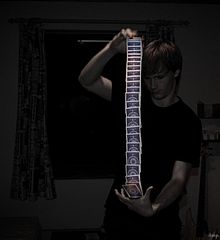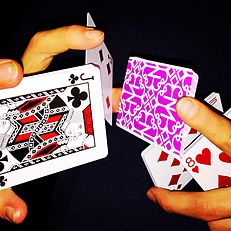Card flourish

David Pedersen's execution of Bone Ho's flourish, "Anaconda"
Card flourishes is the art of cardistry (fancy cuts of playing cards) which includes playing cards.
History
Card flourishing is an art form redirected from cardistry (the art of manipulation of playing cards). In the 20th century the most common flourishes like the Spring were created; at the time the word cardistry was unknown to everybody, including magicians. they would know it by "XCM" , card flourishing was used to show dexterity when doing close-up card magic. Progressively it became an 'art form' by itself.
At the start of the 21st century, card flourishers like De'vo Vom Schattenreich, Bone Ho and Jerry Cestkowski developed a new style of card flourishing which was composed of a lot of aerial moves and eye-catching big displays (Anaconda, The Eye cut etc...). That style was called "Extreme Card Manipulation" or "XCM", as was mentioned before.
Later during the 21st century, the "XCM" lost its popularity and a new and modern 'era' of cardistry was started by Dan and Dave Buck in 2003. They posted the first cardistry video online and encouraged cardistry to develop as an art. This 'era' includes less aerials and eye-catching, hard-to-master moves, but more fluid motions, a lot of two-handed multiple packet cuts as well as one-handed cuts. Cardists like the Buck Twins, Tobias Levin, Chase Duncan, Zach Muller, and Patrick Varnavas are considered to be 'modern' cardists.
Today, there are more and more young people that start practicing card flourishing.
Card flourishing has also gained international attention:
- In 2015 a video produced by The Virts (or Virtuoso), "Air Time" was featured on Uni Lad, and some newspapers and TV channels, like the Discovery Channel.
- April 2015, a three-day conference entirely devoted to cardistry is organised in Brooklyn New York, grouping together the most famous cardists around the world.
- A documentary on card flourishes featuring The Virts (or Virtuoso), "Wild Cards", was produced for the Singapore Stories series on Discovery Channel Southeast Asia in 2015.
Terminology
- Packet - Any amount of cards separate from the rest of the deck; the word "packet" can also mean the deck itself.
- A cut - Any move that cuts the cards, which means to switch or re-arrange the positions of two or more packets of cards.
- Display - A display of packets, single cards or fans, usually held still, then closed.
- Grip - The way the deck is held in the hand.
- Opener - A way to grip the packets or a simple movement used to start or 'open' a flourish.
- Closer - A way to grip the packets or a simple movement used to end or 'close' a flourish.
The different grips
- Dealer's Grip/ Mechanic's Grip - A way of holding the deck where it lies across the palm, and the index finger is on one short side of the deck, the other fingers are on the long side next to it, and the thumb is lying across the other long side of the deck.
- Straddle grip - This grip is similar to the mechanic's grip but has the fourth finger on the opposite end to the first. Used for springs and dribbles for more control over the cards.
- Biddle Grip - Another way of holding the deck, in which the palm is face down, the second and 3rd fingers are at the top short edge of the deck, and the thumb is at the bottom short edge of the deck holding it in position.
- Z grip - This grip is used as the base of many card flourishes. It is accomplished by holding the deck in Mechanics Grip, then raising a packet of cards up from the deck in Biddle Grip while holding another packet between the thumb of the hand in Biddle Grip and the index finger of the hand in Mechanics grip to create a 'Z' formation. This grip is commonly used as it starter.
- 'split grip- which is used for only a small amount of flourishes like "hot shot". which is a way to reveal a spectators chosen card.
Techniques
One-handed Cuts
- The Charlier Cut (also known as the Charlier Pass) is a method of splitting a deck of cards into two parts using one hand. This is typically one of the first flourishes learned by beginner card manipulators, as it is later necessary for some more difficult movements.
- Similar to the Charlier cut, the Thumb Cut also splits the deck into two parts. However, it is much more difficult to execute. The thumb cut requires the flourisher to reach across the deck and use their thumb to raise half the deck upwards. Then he must raise the bottom portion of the deck with his other fingers, completing the flourish. If a flourisher can successfully execute this cut with both hands, he can tackle more advanced cuts that require more dexterity.
- The Scissors Cut is a challenging one handed cut, which is also really used in a lot of card flourishes (Squeeze by Daren Yeow and Very Bad Habit by Brian Tudor). It is also one of the first movements that needs to be acquired before moving forward to more challenging card flourishes.
- The Revolution Cut, created by Brian Tudor is a variation of the charlier cut. Instead of keeping the packets parallel, like in the charlier cut, the top packet executes a 180° rotation. It is also a very common one-handed cut in the cardistry community.
There is a variety of rolling one handed cuts, like the V-cuts by Tobias Levin and the L-cuts by Jerry Cestkowski. In the "rolling one-handed cuts" a single movement is repeated many times to create one continuous visual movement.
Indeed, there is plenty of other one-handed cuts invented by a lot of cardists, like the Muse Cut by Henrik Forberg,and Bella Rev by Nikolaj Pedersen (published in the "B-Bundle", a collection of three of his flourishes) but the ones recited previously are the most 'mainstream' and known ones.
Two-handed Cuts
Two handed cuts are flourishes that utilize both hands.
Cuts such as the "swing" and "swivel" cut are often the first two handed cuts that beginner Cardists learn. They are essential as they provide a basis for more advanced cuts.

Sybil Cut performed by David Mejlhede
The Sybil Cut is the best example of a two handed multiple packet cut, originally performed by Chris Kenner. It has provided the foundation for most two handed cuts that are being developed today. It is among the most well known and recognised flourishes ever created with many artists using it to develop their own flourishes and variations.
The Squeeze cut by Daren Yeow is another good example of a two-handed multiple packet cut. It uses the scissor cut and has become a 'mainstream' move, a 'classic' and is one of the moves that can be considered as a basis for other card flourishes.
the pluto cut by aj steel is another good example of a two-handed three-packet cut this was first introduced on a social media post (tumblr) which slowly grew. and became popular. it includes only the "charlier cut" it is a false cut which means the whole pack may look like its getting shuffled and out of order but it ends up being in the same order as before.
There is a lot of different concepts developed to improve the variety of two-handed cuts:
- Many cuts are based on just taking the packets by the long or short edges and moving them in the two hands in a way that it looks visual. It can sound simple but it is challenging to acquire the mechanics because advanced coordination of the hands is needed and a lot of practice indeed.
- Many really popular cuts are based on a concept in which the packets are taken by the corners to be able to rotate them, like the Skater Cut by Joey Burton, Mockingbird by Daren Yeow, the Tornado cut by Ashford Kneiltel, Phaced by Tobias Levin, Nimbus and Bowtie by Chase Duncan etc... The New Deck Order, a Singapore-based website even released a project on 2015 called Spingod, which included four flourishes by Duy, each using packets gripped by the corners allowing them to rotate.
- An other concept is using single cards as packets. Flourishes like Vine by Tobias Levin,
Snowglobe by Conor O'Kane, Spin Doctor by Nikolaj Pedersen and the emblematic Werm by the Buck Twins are good examples of flourishes using this concept.
One card flourishes
- Card twirls: First popularised by Jeff McBride, card twirls combine many small motions with a single card that, in unison, allow the card to appear as if it is rapidly twirling from finger to finger. These flourishes are generally accomplished by combining small movements of the fingers with a larger motion of the wrist moving to allow the card to "spin" faster than it normally would by simply twirling the card with a still wrist. Currently, the most prominent examples of card twirls are the Virt's "Flicker" and Andrei Jikh's "Bullet." Such card twirls are famous for being simple to master, but just as easy to learn incorrectly which ruins the illusion of the fluidity that is accomplished within the twirl itself.
- Other one card flourishes are Prince Charming by Oliver Sogard and Raccoon by Kevin Ho and the Paddidle.
A project, "The One-Card Ep" was released in 2012. There was instructions for six flourishes, each with a single playing card.
Card Fans
There are several different methods of fanning, some more difficult than others. The simplest method is the thumb-fan, which is done by pivoting the entire deck around your thumb and evenly distributing the cards. Other methods include the pressure fan, the one handed fan, the carnahan fan.
Card spring
Card springs are among the most flashy flourishes. It involves building a lot of pressure on the corners or edges of a deck, then releasing that pressure so there is a steady flow of cards going from one hand to another. Experienced artists can produce springs up to three to four feet long. Variations of this include the upside-down spring, and the waterfall.
COMMENTS








 David Pedersen's execution of Bone Ho's flourish, "Anaconda"
David Pedersen's execution of Bone Ho's flourish, "Anaconda" Sybil Cut performed by David Mejlhede
Sybil Cut performed by David Mejlhede